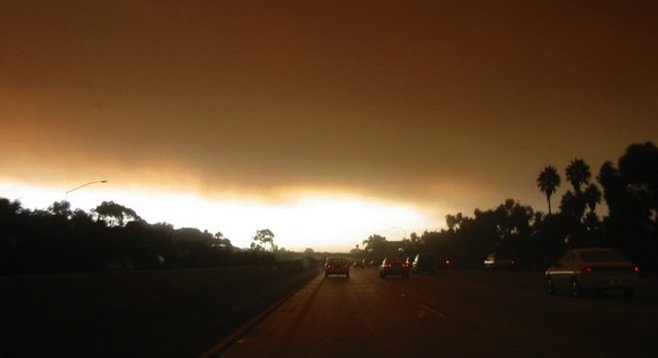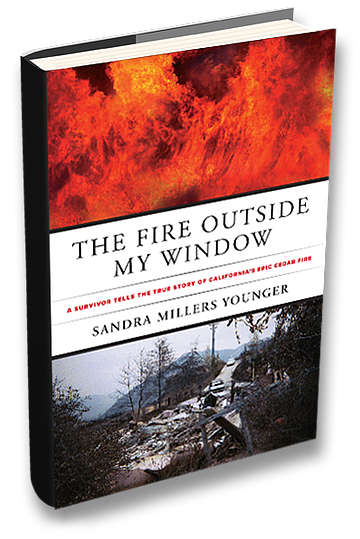 Facebook
Facebook
 X
X
 Instagram
Instagram
 TikTok
TikTok
 Youtube
Youtube

Sandra Millers Younger’s new book, The Fire Outside My Window, is slated for release in conjunction with the tenth anniversary of the Cedar Fire. That devastating natural disaster burned 280,000 acres, destroyed 2,800 homes, and claimed 15 victims. Younger, who lives in Wildcat Canyon, survived the fire.
In the intervening years, Younger has collected over 100 interviews with survivors and the families of the fire’s victims.
“It took a lot of time to organize that and weave together a cohesive narrative that told the story of the biggest wildfire in California history,’ says Younger. “Many times I despaired of ever finishing, but it was such a compelling story that I could neither put it down, nor disappoint the many people who had trusted me with their stories.
“A big part of it was telling the stories of the seventeen people that we lost--15 in the Cedar Fire and two in North County in the Paradise Fire. I was conscious of the fact that they are no longer here to tell their own stories and I felt that was my mandate.”

Much of what the book tries to accomplish is to represent the enormity of the fire’s impact on the people who were stuck in its path. Natural disasters have an unparalleled capacity to inspire terror and awe, and the Cedar Fire was no different. It ravaged San Diego county faster than the speed of communication, making everyone feel, to use Younger’s words, “as if everything was on fire all at once...everyone, everywhere was terrorized.”
“It was as if everything was upended,” Younger continues, attempting to describe the enormity of the fire. “The sky turned brown. The sun was blood red. It was truly apocalyptic.” The disarray was so complete that it even tapped into post-911 anxieties, triggering fears of a terrorist attack.
“I think everyone has already, or will go through some similar defining experience in life, because that’s what life is,” says Younger. “Our experience happened to be a fire rather than some kind of personal disaster, like losing a loved one.” For her, the Cedar Fire was the event that divided her life into two sections: before, and everything after. “The common thread,” she continues, trying to tie together the myriad life-changing events that can happen in the world, “is that you can’t really know what it is like until you’re there. You think you might be prepared for something like that, but there’s no way.
“One of the tasks of The Fire Outside My Window is to help people understand what it really means to be prepared, and how insignificant, in many ways, we are in the face of Mother Nature when she decides to throw a tantrum. We sometimes just have to get out of the way.
“The truth is, there are some unstoppable fires. There are some unstoppable cancers. There are some unstoppable accidents. There are unstoppable adversities in life from which we can only rebound, and learn, and triumph.
“Everybody has resilience,” says Younger. “It’s an innate, human attribute. Any disaster, by definition, is devastating, and there’s no getting around that. But it’s also true, though it sounds Pollyanna-ish, that there is opportunity in every crisis.”
Younger likens the Cedar Fire to the events documented by The Perfect Storm. Every risk factor coincided perfectly, unleashing the conflagration’s full potential. Into the confluence of high winds, dry conditions, and unfortunate timing, a lost hunter started a signal fire as a last-ditch effort at reaching help.
“Some people thought this was simply a local story,” she says, “but [my agent and editor] saw that it was a universal story. It was a story of what happens when incredible forces come together, and of how people respond. When you think about it, The Perfect Storm was a story about fishermen from Gloucester, Massachusetts that no one had ever heard of. Was there ever a more local story? No. It was a universal story, because we all identified with them in their struggle to survive insurmountable odds."


Sandra Millers Younger’s new book, The Fire Outside My Window, is slated for release in conjunction with the tenth anniversary of the Cedar Fire. That devastating natural disaster burned 280,000 acres, destroyed 2,800 homes, and claimed 15 victims. Younger, who lives in Wildcat Canyon, survived the fire.
In the intervening years, Younger has collected over 100 interviews with survivors and the families of the fire’s victims.
“It took a lot of time to organize that and weave together a cohesive narrative that told the story of the biggest wildfire in California history,’ says Younger. “Many times I despaired of ever finishing, but it was such a compelling story that I could neither put it down, nor disappoint the many people who had trusted me with their stories.
“A big part of it was telling the stories of the seventeen people that we lost--15 in the Cedar Fire and two in North County in the Paradise Fire. I was conscious of the fact that they are no longer here to tell their own stories and I felt that was my mandate.”

Much of what the book tries to accomplish is to represent the enormity of the fire’s impact on the people who were stuck in its path. Natural disasters have an unparalleled capacity to inspire terror and awe, and the Cedar Fire was no different. It ravaged San Diego county faster than the speed of communication, making everyone feel, to use Younger’s words, “as if everything was on fire all at once...everyone, everywhere was terrorized.”
“It was as if everything was upended,” Younger continues, attempting to describe the enormity of the fire. “The sky turned brown. The sun was blood red. It was truly apocalyptic.” The disarray was so complete that it even tapped into post-911 anxieties, triggering fears of a terrorist attack.
“I think everyone has already, or will go through some similar defining experience in life, because that’s what life is,” says Younger. “Our experience happened to be a fire rather than some kind of personal disaster, like losing a loved one.” For her, the Cedar Fire was the event that divided her life into two sections: before, and everything after. “The common thread,” she continues, trying to tie together the myriad life-changing events that can happen in the world, “is that you can’t really know what it is like until you’re there. You think you might be prepared for something like that, but there’s no way.
“One of the tasks of The Fire Outside My Window is to help people understand what it really means to be prepared, and how insignificant, in many ways, we are in the face of Mother Nature when she decides to throw a tantrum. We sometimes just have to get out of the way.
“The truth is, there are some unstoppable fires. There are some unstoppable cancers. There are some unstoppable accidents. There are unstoppable adversities in life from which we can only rebound, and learn, and triumph.
“Everybody has resilience,” says Younger. “It’s an innate, human attribute. Any disaster, by definition, is devastating, and there’s no getting around that. But it’s also true, though it sounds Pollyanna-ish, that there is opportunity in every crisis.”
Younger likens the Cedar Fire to the events documented by The Perfect Storm. Every risk factor coincided perfectly, unleashing the conflagration’s full potential. Into the confluence of high winds, dry conditions, and unfortunate timing, a lost hunter started a signal fire as a last-ditch effort at reaching help.
“Some people thought this was simply a local story,” she says, “but [my agent and editor] saw that it was a universal story. It was a story of what happens when incredible forces come together, and of how people respond. When you think about it, The Perfect Storm was a story about fishermen from Gloucester, Massachusetts that no one had ever heard of. Was there ever a more local story? No. It was a universal story, because we all identified with them in their struggle to survive insurmountable odds."
Comments